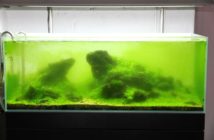“The solution to the pollution is dilution!”
This is one of my favorite sayings and it describes the effectiveness of a water change so precisely. So what is it all about? Why are water changes so important in saltwater aquarium keeping?
To begin, water changes are the most effective form of filtration. They indiscriminately remove everything in the water…from algae fuels such as nitrates and phosphates, to gill burning ammonia. These nutrients can build up in a system and quickly get out of control, especially in smaller aquariums. A protein skimmer, phosphate reactor, and a deep sand bed can all remove nutrients, but each has their own set of limitations. None of these are 100% effective, but a water change is a lot closer to being that effective. You can remove all of the water from your aquarium and replace it with new, phosphate and nitrate-free water. Water changes also add to the stability of your system. By not letting harmful nutrients build up, the water quality stays stable and your tank’s inhabitants can thrive.
In addition to removing detrimental nutrients, a water change can replace exhausted elements. If you have a reef aquarium, the corals will remove certain elements from the water as they grow. These include calcium, magnesium, potassium, iodine, and a whole assortment of other items. This holds particularly true for reef tanks dominated by hard corals and clams. Hard corals absolutely suck up calcium, magnesium, and alkalinity…so much so that systems with these corals usually have a calcium reactor supplying calcium, magnesium, and alkalinity or the hobbyist will manually dose each substance.
So, now that you have seen the light, how much water should you change and how often should it be changed? To be honest, there is no right answer. The general guideline that gets thrown around a lot is 20% of your system’s volume changed every two weeks. Of course, this is just a guideline. You could certainly change more water, more often. I personally like to think about it this way: a reef found in the wild receives a 100% water change every few seconds. Obviously that would not be very economic or convenient for any hobbyist, but we do need to perform large and frequent water changes. World renown aquarist Anthony Calfo was a huge fan of extremely large (in excess of 90%) water changes as often as possible, even on huge systems. He of course had access to fairly pristine sea water from the nearby ocean and was able to pump the water directly from there. So, his water change costs were tiny given the amount of water he was changing.
I personally used to change about 20-30% every two weeks on each of my systems. When I began using the ZEOvit system on my 180 gallon SPS dominated aquarium, I increased the frequency to once a week (be sure to check back for a ZEOvit article). I have since stopped dosing the ZEOvit for various reaons, but have continued my weekly water changes.
To properly do a water change, you’ll need a few things. The first of which is clean water. Water can be purchased at an aquarium store or created by a reverse osmosis with deionization (RO/DI) unit. Water from an aquarium store is also created by RO/DI, and be purchased premixed or unmixed. Be careful with premixed water though as that store might keep their salinity at a lower or higher level than what you keep in your tank. If you buy or make freshwater, you’ll need to also purchase a bucket of sea salt and mixing equipment. The equipment list includes a water mixing pump, a refractometer or hydrometer (please, stay away from hydrometers), a heater, and a container in which to mix the water. Large Rubbermaid trashcans work perfectly for mixing water, but don’t use a previously used one as they will be tainted with chemicals and trash. Add water to the container, then add salt a little at a time until the desired salinity is reached. Then allow the water to mix for an additional 24-48 hours to help stabilize the pH and salinity. Next, perform the water change.
The best way to do a water change is to simply turn off all of your aquarium equipment and siphon out the desired amount of water. Prior to siphoning, many people will scrape the tanks walls to remove various algae that build up. Some will also clean off their rocks if detritus, slime algae, or other nuisance algae has built up there as well. Then, the gunk can be removed during the water change. Another thing to remember when siphoning is to LEAVE THE SANDBED ALONE! Do not siphon the sand bed. There are various beneficial organisms living in the sand that are food sources for aquarium livestock. Additionally, and more importantly, disturbing the lower levels of a deeper sand bed can yield negative results. Because lower levels in the sand are anoxic, or lacking oxygen, there are certain bacteria that live there and convert nitrate into nitrogen gas. Other, more harmful chemicals will also build up in these lower levels. If you disturb the sand, you can potentially release harmful chemicals back into your water as well as remove your nitrate processing bacteria.
Changing out aquarium water is a very simple and effective way to reduce nutrients in your aquarium and make it more stable. It’s the most effective form of filtration and will make your aquarium a much healthier environment.





